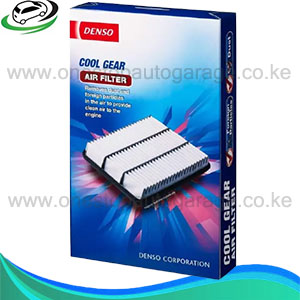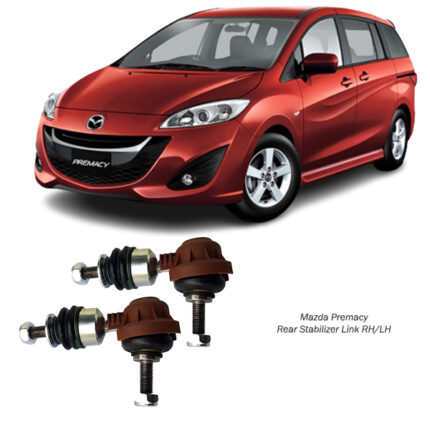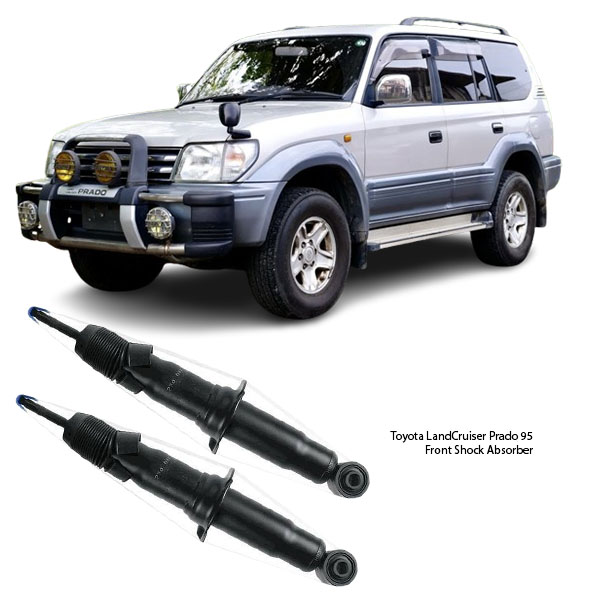-6%
Get Toyota LandCruiser Prado 95 Front Shock Absorber Assy 341232 in Kenya
The Front Shock Absorber Assembly is a vital part of a vehicle’s suspension system. It plays a central role in absorbing road shocks, enhancing ride comfort, and maintaining vehicle control. Positioned between the chassis and the front wheels, the shock absorber assembly ensures that the tire maintains consistent contact with the road surface while minimizing the impact of road irregularities.
Primary Function
The primary role of the front shock absorber assembly is to:
-
Dampen oscillations caused by bumps and dips in the road.
-
Control suspension movement, reducing bounce, sway, and body roll.
-
Improve handling and braking performance by maintaining tire contact.
-
Stabilize the vehicle’s ride height and alignment in dynamic driving conditions.
Without a properly functioning front shock absorber, a vehicle would continue to bounce uncontrollably after every bump, making driving unsafe and uncomfortable.
Components of a Front Shock Absorber Assembly
A typical Front Shock Absorber Assembly includes several integrated parts:
1. Shock Absorber (Damper)
This is the main cylindrical component that uses hydraulic or gas pressure to resist compression and rebound movements. It converts kinetic energy from suspension motion into heat, which is dissipated through hydraulic fluid.
2. Coil Spring (in Strut-Type Assemblies)
In many front suspensions (like the MacPherson strut), the coil spring is mounted around the shock absorber. It supports the weight of the vehicle and works together with the shock to absorb vertical motion.
3. Strut Housing
In strut-based systems, the strut housing serves as a structural component connecting the suspension to the steering knuckle. It holds the damper and spring in place and contributes to alignment geometry.
4. Mounting Plate / Strut Mount
Located at the top of the assembly, it connects the strut to the vehicle’s body. It may include a bearing to allow rotation as part of the steering system.
5. Dust Boot
Protects the piston rod of the damper from dust, mud, and debris, which could otherwise cause premature wear or leaks.
6. Bump Stop
A rubber or polyurethane component that prevents the suspension from compressing beyond its limit during extreme conditions.
Types of Shock Absorber Assemblies
Depending on the vehicle and suspension design, front shock absorber assemblies can differ:
– Twin-Tube Shock Absorbers
The most common type, featuring an inner (working) tube and an outer (reserve) tube. Hydraulic fluid flows between the two as the piston moves.
– Mono-Tube Shock Absorbers
Use a single cylinder with a floating piston separating gas and oil chambers. Offer better heat dissipation and are used in performance and heavy-duty applications.
– MacPherson Strut Assembly
Combines the shock absorber and spring into a single structural unit, commonly used in front suspensions of modern cars.
– Gas-Charged Shock Absorbers
Contain pressurized nitrogen gas in addition to hydraulic fluid to prevent foaming, improving damping consistency and response.
Construction Materials
-
Piston Rod: Usually made of hardened, chrome-plated steel for durability and smooth movement.
-
Shock Body: Steel or aluminum, often coated or painted for corrosion resistance.
-
Seals: High-quality rubber or synthetic material to prevent oil leaks.
-
Spring (if included): Heat-treated steel with powder coating to resist corrosion and fatigue.
Working Principle
The shock absorber contains a piston that moves inside a fluid-filled cylinder. When the vehicle encounters a bump, the piston compresses or extends, forcing fluid through small orifices or valves. This resistance slows down the movement, converting kinetic energy into thermal energy, which is then dissipated.
This process:
-
Reduces rebound and compression after an impact.
-
Stabilizes vehicle movement.
-
Controls suspension motion to prevent excessive oscillation.
Position and Installation
The front shock absorber assembly is mounted between the wheel assembly (via the steering knuckle or control arm) and the vehicle’s body or chassis. Installation specifics depend on:
-
Suspension design (strut-type or shock-only)
-
Vehicle type (passenger car, SUV, truck)
-
Alignment requirements (some struts affect camber)
Proper installation is crucial for maintaining steering geometry and ride height.
Common Symptoms of a Failing Front Shock Absorber
Over time, front shock absorber assemblies are subject to wear and fatigue. Common signs of failure include:
-
Excessive bouncing over bumps.
-
Nose-diving when braking.
-
Uneven or rapid tire wear.
-
Poor steering response or wandering.
-
Fluid leaks from the shock body.
-
Knocking sounds during driving.
-
Tilted ride height or sagging on one side.
Driving with worn shocks can lead to poor vehicle control, increased stopping distance, and compromised safety.
Expected Lifespan
The lifespan of a front shock absorber depends on:
-
Road conditions
-
Driving habits
-
Vehicle load
-
Quality of the part
On average, shock absorbers may need replacement between 60,000 to 100,000 kilometers, although premium versions or heavy-duty models may last longer.
Compatibility and Variations
Front shock absorber assemblies are vehicle-specific, and compatibility depends on:
-
Vehicle make, model, and year.
-
Engine size and drivetrain (FWD, AWD).
-
Suspension type (standard, sport, off-road).
-
Ride height (OEM vs lifted or lowered setups).
Some vehicles also offer electronic or adaptive dampers, which adjust shock stiffness based on driving conditions.
Manufacturing Standards and Testing
High-quality shock absorbers are manufactured with strict tolerances and tested for:
-
Durability under load.
-
Corrosion resistance.
-
Leak integrity.
-
Damping force consistency across temperatures.
-
Fitment precision for safe and reliable installation.
Manufacturers often use advanced testing equipment to simulate real-world conditions and ensure long service life.
Maintenance Considerations
While shock absorbers are generally maintenance-free, periodic inspection is recommended, especially if:
-
The vehicle is used off-road or in rough terrain.
-
You notice changes in ride quality or handling.
-
Replacing other suspension components (springs, bushings).
It’s common to replace front shocks in pairs (left and right) to maintain balanced performance.
The Front Shock Absorber Assembly is a fundamental suspension part that greatly influences ride comfort, vehicle handling, and safety. With its complex role in absorbing road shocks and stabilizing suspension motion, this component must be carefully matched to the vehicle and maintained in good working condition to ensure peak driving performance.
Follow us on Facebook for more parts.



